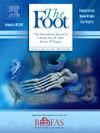Displaced, intra-articular fractures of the calcaneus: Review of non-operative management, open reduction internal fixation and novel minimally invasive techniques
Q2 Health Professions
引用次数: 0
Abstract
Calcaneal fractures comprise 1–2 % of all fractures and typically occur in younger, working age male patients. These injuries result in a significant burden to the patient in terms of residual pain, inability to work or participate in sports, difficulty with shoe wear and secondary reconstructive surgery such as subtalar arthrodesis. They also result in a significant burden to the healthcare system. Calcaneal fractures can be sub-classified into extra-articular and intra-articular, two-thirds of calcaneal fractures involve the articular facets of the subtalar joint. The treatment of displaced intra-articular calcaneal fractures is controversial, with many authors recommending non-operative treatment. The concerns with this approach include painful malunion, articular surface disruption, heel varus and increased calcaneal width, with a significant rate of secondary reconstructive surgery. Traditional operative approaches for calcaneal fractures allowed the surgeon to restore anatomic parameters, but have been associated with high rates of soft tissue complications, up to 40 % in some series. Newer, less invasive techniques for fixation allow the surgeon to obtain a similar anatomic reduction with reduced tissue compromise. We performed a systematic literature search which identifed forty articles on which this review is based. In this review article we discuss the background of displaced, intra-articular calcaneal fractures and compare the current knowledge base of operative vs. non-operative management. We then compare and contrast the three common surgical approaches used for treatment of these injuries: the extensile lateral approach, the sinus tarsi approach and newer percutaneous/minimally invasive techniques. At the current time, the sinus tarsi approach is the mainstay for treating these fractures, with most authors favouring this over the extensile lateral approach. There is momentum for adoption of newer minimally invasive techniques which show promising results, with reduced soft tissue complications and satisfactory functional outcomes.
跟骨移位、关节内骨折:非手术治疗、切开复位内固定和新型微创技术综述
跟骨骨折占所有骨折的1-2 %,通常发生在年轻,工作年龄的男性患者。这些损伤给患者带来了严重的负担,包括残余疼痛、无法工作或参加运动、穿鞋困难和继发性重建手术,如距下关节融合术。它们也给医疗保健系统带来了沉重的负担。跟骨骨折可分为关节外骨折和关节内骨折,三分之二的跟骨骨折涉及距下关节的关节面。移位的跟骨关节内骨折的治疗是有争议的,许多作者推荐非手术治疗。该入路的问题包括疼痛的骨不愈合、关节面破裂、足跟内翻和跟骨宽度增加,并且二次重建手术的发生率很高。跟骨骨折的传统手术方法允许外科医生恢复解剖参数,但与软组织并发症的高发生率相关,在某些系列中高达40% %。更新的、侵入性更小的固定技术使外科医生能够在减少组织损伤的情况下获得类似的解剖复位。我们进行了系统的文献检索,确定了本综述所依据的40篇文章。在这篇综述文章中,我们讨论了移位,关节内跟骨骨折的背景,并比较了目前手术与非手术治疗的知识基础。然后,我们比较和对比了用于治疗这些损伤的三种常见手术入路:可伸展外侧入路、跗骨窦入路和较新的经皮/微创技术。目前,跗骨窦入路是治疗此类骨折的主要方法,大多数作者倾向于采用这种入路而不是可伸展外侧入路。有动力采用新的微创技术,显示有希望的结果,减少了软组织并发症和令人满意的功能结果。
本文章由计算机程序翻译,如有差异,请以英文原文为准。
求助全文
约1分钟内获得全文
求助全文
来源期刊

Foot
Health Professions-Podiatry
CiteScore
2.00
自引率
0.00%
发文量
37
期刊介绍:
The Foot is an international peer-reviewed journal covering all aspects of scientific approaches and medical and surgical treatment of the foot. The Foot aims to provide a multidisciplinary platform for all specialties involved in treating disorders of the foot. At present it is the only journal which provides this inter-disciplinary opportunity. Primary research papers cover a wide range of disorders of the foot and their treatment, including diabetes, vascular disease, neurological, dermatological and infectious conditions, sports injuries, biomechanics, bioengineering, orthoses and prostheses.
 求助内容:
求助内容: 应助结果提醒方式:
应助结果提醒方式:


